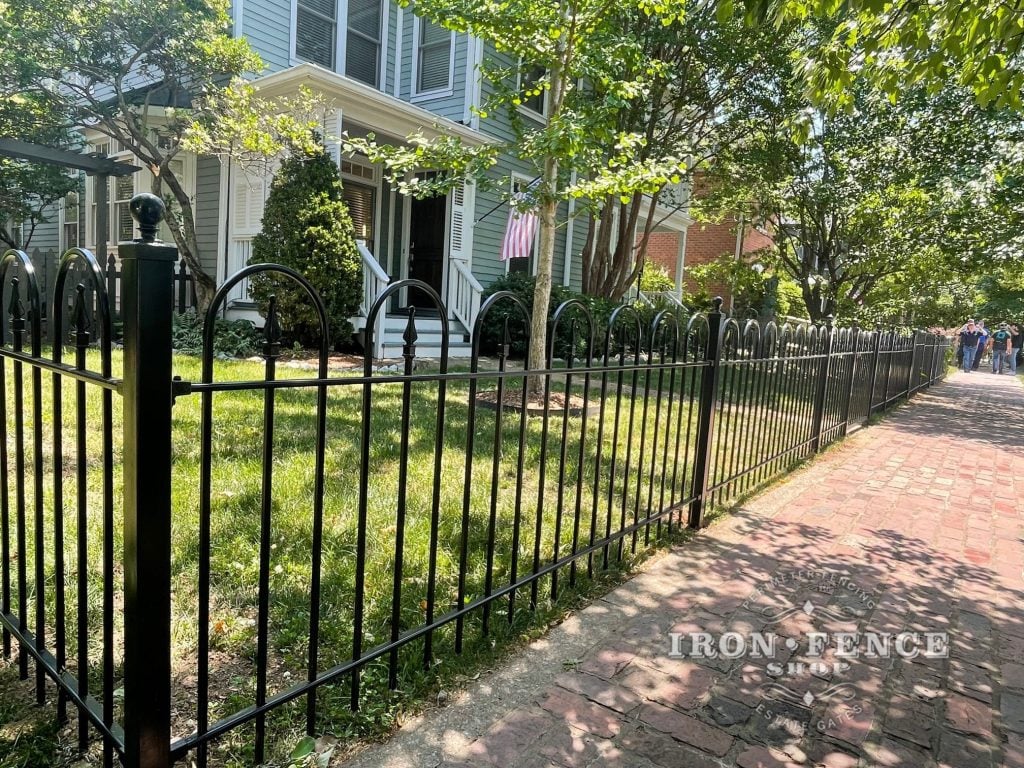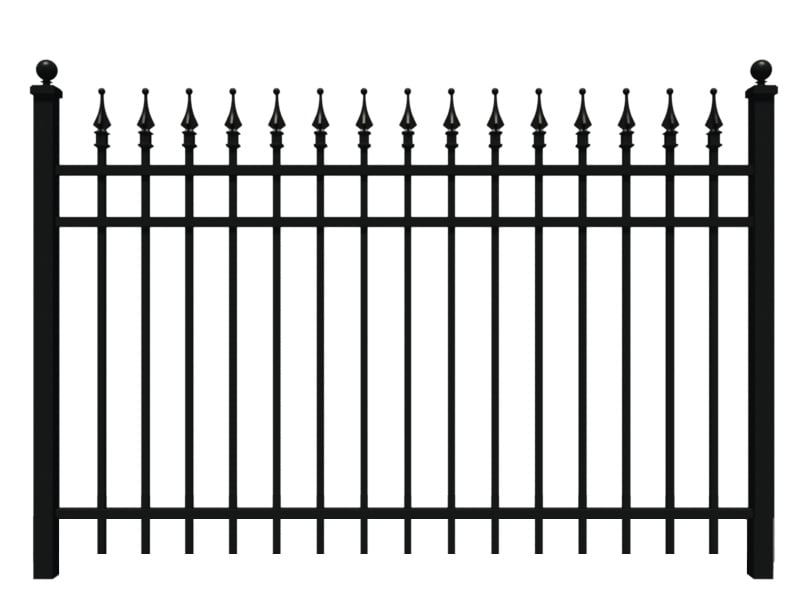
Choosing the right fence for your property is about more than just appearances. It’s a long-term investment that affects your budget, maintenance needs, property value, and even your environmental footprint. Whether you’re upgrading your current fence or planning a new install, comparing the cost and benefits of different fencing materials is a smart place to begin.
This guide will help you weigh how metal fencing compares to other common materials—like wood, vinyl, and composite—across key factors like price, maintenance, durability, and design flexibility.
Understanding Initial Costs
First things first: what does it cost to get these fences in the ground?
Metal vs. Wood Fencing
Metal fencing—specifically iron and aluminum—typically comes with a higher cost at first, but offers greater long-term value. Instead of being priced by linear foot, fencing from Iron Fence Shop is sold in fixed panel sizes. Aluminum fence panels range from $116 to $231, while steel panels range from $293 to over $600, depending on size, design, and grade.
In comparison, wood fencing varies from $10 to $30, depending on the type, with pine and cedar being the most affordable and woods like redwood costing more.
Installation tells a similar story. Metal fencing is heavier and may require welding or precise alignment, which can increase labor costs. Meanwhile, wood fencing is quicker to install, especially simpler designs like picket fences or split-rail styles.
That’s where companies like Iron Fence Shop come in—offering prefabricated aluminum and wrought iron fencing systems that simplify installation, reduce labor costs, and deliver long-term savings without sacrificing durability or design. Their ready-to-assemble panels are engineered to save time during setup while still providing the premium look and strength that make metal fencing so desirable.
So, while metal may seem more expensive at first glance, wood’s frequent upkeep and shorter lifespan can lead to higher costs down the road.
Vinyl vs. Metal
Vinyl fencing tends to compete well on price. Depending on the style, expect to pay between $20 and $40 per foot for materials. Vinyl installs quickly and easily thanks to interlocking fence panels, which may reduce labor costs.
However, vinyl’s intricate design options are somewhat limited. It generally lacks the aesthetic appeal and structural integrity of decorative metal fencing. For projects where longevity and timeless style are must-haves, homeowners should turn to trusted experts for versatile metal options that balance cost and customization.
Composite vs. Metal
Composite fencing—made from a mix of recycled wood fibers and plastic—ranges from $11 to $45 per foot. It’s typically heavier than vinyl and may require more skilled installation, adding to overall labor costs.
On the other hand, aluminum fencing (especially powder-coated styles) offers exceptional value: lightweight, easy to install, and remarkably resistant to weather and wear.
Composite may appeal to eco-conscious homeowners, but metal often pulls ahead with its durability and wide design variety.
| Smart Move: When comparing fence materials, factor in total cost of ownership—not just upfront pricing. Metal fencing may cost more initially, but its low maintenance, long lifespan, and resale value can make it the most cost-effective choice over time. |
Maintenance Costs Over Time
Upfront costs are just one part of the equation. Fencing requires care to stay safe, attractive, and functional.
Why Metal (Wrought Iron and Aluminum Fences) Wins on Maintenance
Metal fencing, especially aluminum fences and galvanized steel fencing, requires minimal upkeep. Occasional cleaning and periodic rust-proofing (only for certain metals) are typically all that’s needed.
Powder-coated options—like those available from Iron Fence Shop—come with durable finishes that prevent corrosion and preserve appearance for years, even in harsh climates.
How Wood Stacks Up
Wood fencing needs more frequent care. You’ll likely need to stain, paint, or seal it every couple of years—plus patch up any damage from pests, moisture, or rot. All this upkeep adds time and cost over the years.
Vinyl & Composite Maintenance
Vinyl is low-maintenance but can crack over time in cold weather. If damage occurs, replacing entire panels is often necessary. Composite is similarly low-maintenance but may need mold treatments in highly humid areas.
Neither usually requires repainting or sealing, which is great—but any repairs due to age or weather can come with steep price tags.
Longevity and Durability of Each Fencing Material
Choosing a fence should be a long-term decision—so how long will each option last?
| Material Fence Type | Average Lifespan |
| Wrought Iron Fencing | 50+ years |
| Powder-Coated Aluminum | 30–50+ years |
| Galvanized Steel | 20–40 years |
| Wood | 10–20 years |
| Vinyl | 20–30 years |
| Composite | 25–30 years |
Wrought iron fencing and aluminum fences lead the way when it comes to durability, outlasting most other materials by decades. And with proper protective coatings or treatments, metal can hold up beautifully across the seasons.
Wood’s lifespan is shorter unless it’s meticulously maintained. Vinyl and composite fare well, though durability often depends on climate and installation quality.
For fencing solutions built to last—with styles that don’t fade with age—Iron Fence Shop’s metal fencing continues to be a go-to for homeowners seeking long-term value.
Comparing Installation Costs
You’ve priced the materials. Now, let’s cover what it takes to get them installed.
Average Installation Cost by Material
| Material | Initial Cost (per foot) |
| Metal | $15–$80 per foot (based on panel size and type) |
| Wood | $10–$30 |
| Vinyl | $20–$40 |
| Composite | $11–$45 |
Note: Metal fencing from Iron Fence Shop is sold in fixed panel sizes. Per-foot costs above are estimated for comparison and do not include installation, posts, or hardware.
While metal—especially wrought iron—typically requires more precise installation, Iron Fence Shop’s pre-engineered, fully welded systems are designed to reduce on-site labor and complexity.
Features like routed aluminum posts, pre-welded panels, and properly squared gates make installation easier and more efficient than traditional custom fabrication.
By contrast, other types of fencing often involve heavier materials and precision cuts, placing it mid-range in installation difficulty and labor requirements.
Hidden Costs to Watch For
Not all expenses are visible up front. Over time, repairs, maintenance, and limited warranties can add to the true cost of ownership—a surprise many homeowners aren’t prepared for.
- Wood: Requires recurring staining, pest prevention, and structural patchwork.
- Vinyl: May become brittle or discolored, especially in extreme sun or cold.
- Composite: Susceptible to fading, mildew, or panel warping in humid climates.
- Metal: Minimal hidden costs, especially with powder-coated aluminum fences or galvanized steel fencing.
And warranties matter. Look into what’s covered—and what voids the guarantee. Solid manufacturers stand behind their products with industry-best warranties and clear, honest policies.
| Smart Fence Buyer Tip: Before committing, ask the manufacturer for a sample warranty and proper maintenance guide. This gives you a clear picture of long-term upkeep and potential exclusions—so you’re not caught off guard down the line. |
Aesthetic Appeal and Customization Options
Great fences do more than define property—they shape first impressions. Material options greatly affect your ability to customize.
Metal Fencing Flexibility
Metal offers everything from sleek modern lines to ornate scrollwork. Want something unique? Iron Fence Shop offers customizable heights, finials, post caps, and arches that reflect your home’s architecture—without the complexity of fully custom fabrication.
Finishes are just as flexible. From matte black powder coats to bronze, metal finishes can add sophistication that lasts.
Wood’s Historic Style
If you love a classic look, wood can be incredibly adaptable—gable tops, latticework, carvings, and natural grains bring warm, traditional charm. Just remember: each customization adds both upfront and long-term costs.
Vinyl & Composite Styles
Vinyl mimics wood (to a point) but can sometimes appear flat or plastic in texture. Composite fencing gets closer to wood tones and textures, though it’s typically less customizable than real lumber or iron.
Environmental Considerations
For eco-conscious homeowners, choosing the right fencing material means considering both lifespan and environmental impact. Here’s how common options compare:
- Metal: Often contains recycled content and is fully recyclable at end-of-life.
- Wood: Renewable when FSC-certified, but chemical treatments reduce eco-friendliness.
- Vinyl: Made from PVC, difficult to recycle, and can release pollutants during production.
- Composite: Often made from recycled plastics and wood, but energy-intensive to make.
Because aluminum and steel last for decades and avoid landfill waste, steel fencing in particular stands out as a highly eco-friendly choice—especially when sourced from companies like Iron Fence Shop that emphasize recyclability, durable finishes, and long-term performance.
What’s the Best Value?
When it comes to lasting value, metal fencing outperforms alternatives in durability, appearance, and long-term cost of ownership. While other materials may offer lower upfront pricing, they require more frequent maintenance, repairs, or eventual replacement.
Iron Fence Shop sets itself apart by offering high-quality iron and aluminum fencing systems that are built for long-term performance. Their fences feature fully welded finials made from true iron or aluminum—not plastic—and aluminum posts routed for a tighter, cleaner fit. Wrought iron panels are hot-dip galvanized and finished with UV-resistant powder coating to resist rust, corrosion, and fading in any climate.
Everything is engineered for easier installation with long-lasting results, and backed by some of the strongest warranties in the industry—25 years on iron, lifetime on aluminum.
With a personalized buying process that ensures every detail is right from the start, Iron Fence Shop doesn’t just sell fencing. They deliver peace of mind, craftsmanship, and value built to last.
 Free Shipping over $5,000
Free Shipping over $5,000
 15 Years in Business
15 Years in Business
 18mo No Interest Financing
18mo No Interest Financing




